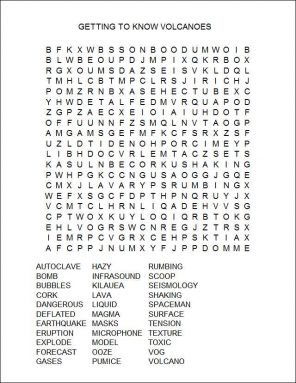Cool Jobs: Getting to know volcanoes
It’s too hot and dangerous to go inside a volcano, so these scientists explore them in other ways
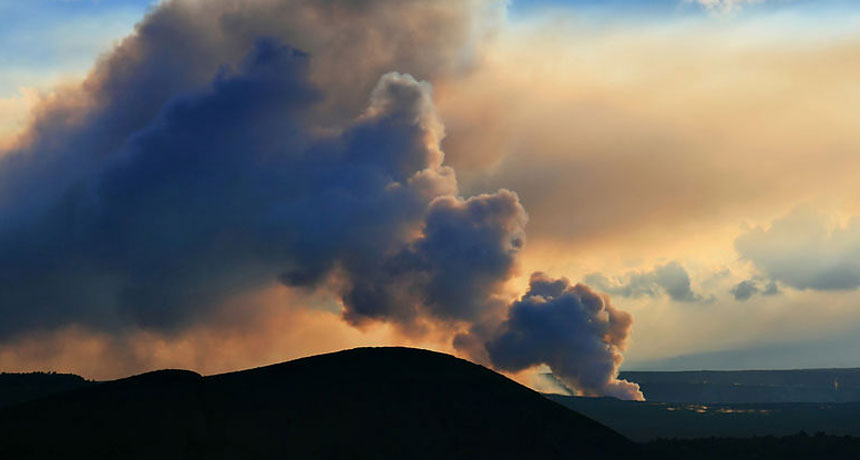
Plumes of sulfur dioxide gas billow from the Halema’uma’u vent of the Kilauea volcano in Hawaii. Those gases are also turning into vog.
Brocken Inaglory/ Wikimedia Commons (CC BY-SA 3.0)
By Ilima Loomis
Something was wrong with Ben Kennedy’s pumice. He had placed the porous, volcanic rock into an autoclave. The high temperature and pressure inside this device would imitate the interior of a volcano. But when the scientist opened the door to take out the rock, it had shrunk. It was now only about half its original size.
Kennedy didn’t think it had simply melted. “The weird thing was, it didn’t just shrink vertically,” he recalls. “It also shrank sideways.” Kennedy began a years-long quest to figure out what had happened to his pumice. It would lead this volcanologist to a discovery that changed scientists’ understanding of how volcanoes work.
Ancient volcanoes helped build and shape our world. Their eruptions create new land. They’re also a dramatic force of destruction. People who live near a volcano may have to leave their homes when lava flows out. When an eruption spews clouds of ash into the air, planes have to fly around it. Even hundreds of miles away, volcano smoke — called vog — can pollute the air and make it hard for some people to breathe.
Extreme temperatures, frequent explosions and poisonous gases make it impossible for people to climb inside an active volcano. It can be difficult to even get close. So scientists use other tools to learn about them. They study samples of lava or write computer programs to simulate explosions. Some even use the equivalent of a stethoscope to listen to a volcano’s internal gurgling and coughs.
Here are three people who are helping explain how volcanoes work — from the inside out.
The incredible, shrinking pumice
Kennedy works at the University of Canterbury in Christchurch, New Zealand. He had set out to study what happens to water when it mixes with magma — or liquid rock — inside a volcano. But he was so curious about what had happened to his pumice that he had to learn more. “That became the focus of the research,” he says — “to try and work out why the pumice was shrinking in this weird way.”
He and his colleagues started by reading about foam. Pumice is similar to foam, because it too is full of air bubbles. Those bubbles connect to one another. This lets gas pass through the rock. Some bubbles are large enough to see. Others are tiny — so small, a human hair could not squeeze through. When the scientists repeated their heating of the pumice and looked at what happened to its bubbles, they spied a clue.
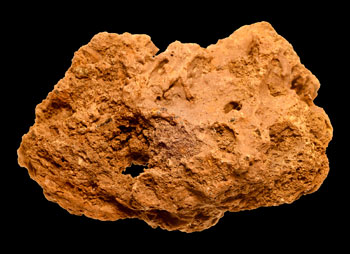
“A lot of these really small bubbles had disappeared,” Kennedy says. It was their first inkling that the shrinking had something to do with the molten rock’s surface tension. Surface tension is the force that holds a droplet of water together. It causes the molecules in a liquid to pull closer together.
To learn more, his team sought to find out how fast the pumice shrank. “We didn’t know if the change happened in the first five minutes or if it happened gradually,” Kennedy says. So they repeated the test yet again. This time, before they started, they replaced the autoclave door with strong, heat-resistant glass. It let them see inside and measure how quickly the rock shrank. The results proved surface tension indeed was at play.
Even Kennedy was surprised. “Surface tension is an incredibly small force,” he says. “When people think about volcanoes, they think surface tension is insignificant, because there are such bigger things going on.”
On bubbly lava
The findings help explain how some volcanoes work. In the past, volcanologists believed that flowing lava sinks back down after an eruption, pressing on the magma below and squashing all the bubbles. Pressure builds up under the compacted lava. This leaves the lava, like a cork, plugging up the volcano — until it explodes. This suggests why some volcanoes will go through cycles of flowing and explosive eruptions.
“We’re not saying that’s not true,” he now says. “But there’s actually a lot of volcanoes that don’t do that.”
Some volcanoes simply don’t explode. Kennedy and his colleagues showed how surface tension could let lava release gas without pressure, by collapsing the tiny bubbles inside. “A pressurized volcano explodes. A less pressurized volcano might just ooze more lava out,” he explains.
The team checked its results against a real volcano in Japan that behaved in this way. They studied samples of its cooled lava. “We looked at the textures,” he says. “And you could see they were missing the small bubbles, in the same way we were missing the small bubbles in our experiment.”
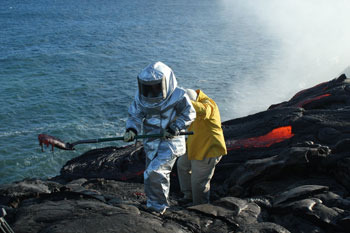
How could something as small as surface tension make a difference in a volcano? “Often inside a volcano, a lot of your forces are actually quite balanced,” Kennedy says. Even when magma has the weight of lava and rock squashing it from above, it also has pressures building up below. Sometimes, the small force of surface tension is enough to tip the balance, he now concludes.
Kennedy traveled to Hawaii to study lava from Kilauea volcano. A TV crew filmed the trip. “I got to wear one of those ridiculous silver spaceman suits, scoop out some flowing lava with a big spade, and we could see that it was also deflated. So the same thing was going on in Hawaiian lava flows.”
But, he notes, the fancy gear was “mostly for show.” The gloves were so thin, his hands got scorched as he dug into the 1,000° Celsius (1,830° Fahrenheit) lava.
“To be honest, those suits are something people do for TV. It’s much more effective to just wear firefighters’ equipment,” he says. “The most important thing is good gloves and a face shield.”
Listening to a volcano
When David Fee’s phone rings in the middle of the night, he knows it’s probably just his volcano alarm.
Fee is a scientist with the Alaska Volcano Observatory. He studies noises produced by volcanoes at low frequencies called infrasound. These are sound waves so deep and low, humans can’t hear them. But listening for them with special equipment can tell scientists when a volcano is acting up.
That’s what happened one night last July. A microphone near Alaska’s Cleveland volcano recorded the telltale low rumbling of an explosion. A computer monitoring the microphone recognized that an eruption was underway. So it sent an automatic text message to Fee, waking him up. It was his job to look at the data and confirm it — then warn officials if the eruption was dangerous.
Fee studied geophysics in graduate school. He had done some work in seismology, the study of earthquakes. Then he learned about infrasound and got excited to study volcanoes by listening to them. “I enjoy seismology, but there had been a lot of work done already,” he says. “Infrasound was new, with a lot of discoveries still to be made.”
Infrasound reveals many clues about a volcano — starting with whether or not it’s even erupting. “That sounds obvious, but it’s sometimes very difficult to determine,” Fee says. Seismic activity, or shaking in the ground, may just be the result of an earthquake. Sound is sometimes the only sure way to know if an eruption is underway. This is especially true in a place like Alaska. If an eruption happens far from people in an area covered by clouds, no one will know it.
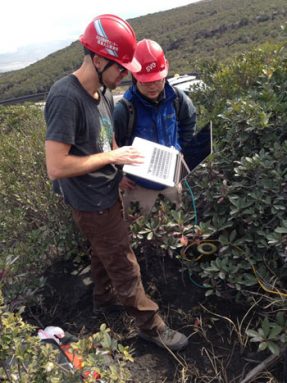
Infrasound also can help scientists pinpoint an eruption — useful when two volcanoes are close together. And the size and shape of the sound waves can tell scientists something about what’s coming out — like how much ash a volcano is producing, how fast the ash is moving and how big the plume will get.
Before he can start recording and studying a volcano’s sound, Fee needs to get his microphones in just the right spots. Some volcanoes are nearby and easy to reach. When he can, he likes to put as many as 10 or 12 microphones around the volcano, to record all its roaring and rumbling. “More is always better,” he says. But sometimes he must go to remote or dangerous areas. That might mean he can only set up one microphone to listen to several nearby volcanoes.
He and his team may spend a week or two around the volcano. They set up equipment, test it to make sure it works and gather other data. They might use infrared cameras to take pictures of the hot material coming out of the volcano, or study the amount and types of gases being emitted. They always wear hard hats and carry gas masks. This is to protect themselves from flying rocks and poisonous air. They keep a close eye on the volcano, and stay in contact with one another. “You have to pay attention at all times, because things can change quickly,” Fee says.
In addition to monitoring volcanoes in Alaska, Fee and his colleagues visit other parts of the world to study volcanic infrasound. In a remote mountain range in Russia, he could hear the volcanoes rumbling and feel the ground shaking under his feet. But that wasn’t the only thing he had to worry about. “It’s hot, there’s bugs, there’s bears around, and you have an explosive volcano just a few miles away at the same time,” he recalled.
Back in July, when Fee’s volcano alarm woke him up, he got out of bed and studied the data. The microphones had picked up an infrasound signal that was very loud, but short. That meant the eruption had only lasted a few seconds. The recording station registered the roughly 135 decibel sound. That’s intense. If it had been audible to people, it would have had “a similar loudness to being close to a jet engine or loud gun,” Fee notes.
“It was a simple, quick explosion,” the data showed. “So it was likely a small ash cloud,” Fee concluded. He helped get the information to authorities. Just to be safe, they then set up temporary flight restrictions in the area.
Fee says he likes knowing that his work can help make a difference in the real world. “I don’t like to be woken up at 2 a.m., but it’s very satisfying to see that in play,” he says.
Cloudy, with a chance of vog
When a volcano erupts, lava isn’t the only danger to people living nearby. Gas and dust can fill the air with a hazy smoke called vog. “It’s highly toxic,” says Steven Businger. “It causes burning eyes and hurts the throat. People who are sensitive to it can have asthma attacks or breathing problems.”
Businger is an atmospheric scientist at the University of Hawaii at Manoa. He worked with researchers at the Hawaii Volcano Observatory to develop a computer model that predicts how vog will spread. They report predictions made by the model on a website. It provides a daily vog forecast.
On the island of Hawaii, vog is most concentrated downwind of the island’s active volcanoes. But under the right conditions, it can spread across the entire state, more than 480 kilometers (300 miles). Besides making it hard to breathe, vog can also be bad for business. Flower farmers near the volcano sometimes lose their crop when their plants and blossoms are burned by the toxic chemicals. And on the island of Maui, more than 100 miles away, a local sugar plantation can’t burn its fields for harvest when vog is already polluting the air.
To model current vog conditions, scientists measure the amount of sulfur dioxide gas that the Kilauea volcano is spewing. They use what they know about the gas’s properties and how it spreads. Then they add wind forecasts. By combining the information in a computer program, they can predict how vog will likely spread around the island and across the state.
Many government agencies rely on the university’s model. Businesses and individual people check the website daily for its predictions. This lets them plan their activities in such a way as to avoid vog. And local meteorologists use the site to provide a daily vog forecast on the TV news.
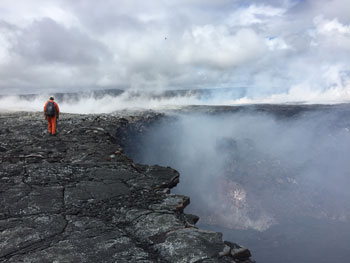
“We had a pretty good idea of where the vog was going” even before they created the model, Businger says. “It was satisfying that we were able to get a model prediction that was good enough for people to benefit from it.”
Their research has also turned up some new insights on vog. For instance, Businger notes, “We discovered that when a vog plume is ingested into a hurricane, it produces more lightning.”
Next, he would like to study if the chemicals that make up vog act differently when the air is cloudy, compared to when it’s clear. Knowing this could improve vog forecasts even more.
But the scientists’ biggest challenge isn’t a volcano — it’s funding. The vog model cost about $400,000 to develop. To keep it running, it now costs another $100,000 to $150,000 each year. Businger is working with a group of state and other government agencies, hoping they can combine funds to support the project.
“There are thousands of people a day who visit that site,” he says. If the money dries up, “It could close down tomorrow,” he warns.
Funding is far from the only challenge facing volcano scientists. They also must be prepared to deal with poisonous gases, extreme heat and dangerous “lava bombs.” But for now, these researchers will continue their work to better understand the Earth and keep people safe. And one reason they just keep forging on: their love of volcano science!
This is one in a series on careers in science, technology, engineering and mathematics made possible with generous support from Alcoa Foundation.
Power Words
(for more about Power Words, click here)
asthma A disease affecting the body’s airways,which are the tubes through which animals breathe. Asthma obstructs these airways through swelling, the production of too much mucus or a tightening of the tubes. As a result, the body can expand to breathe in air, but loses the ability to exhale appropriately. The most common cause of asthma is an allergy. It is a leading cause of hospitalization and the top chronic disease responsible for kids missing school.
atmospheric science A field of meteorology that is related to climate science and pollution impacts. People who work in this field, called atmospheric scientists, use computers and math to model the properties of Earth’s atmosphere that drive weather, climate and the movement of gases and pollutants through the air.
autoclave A heated pressure chamber, normally used to sterilize instruments.
computer model A program that runs on a computer that creates a model, or simulation, of a real-world feature, phenomenon or event.
geophysics The study of matter and energy on Earth and how they interact.
graduate school Programs at a university that offer advanced degrees, such as a Master’s or PhD degree. It’s called graduate school because it is started only after someone has already graduated from college (usually with a four-year degree).
infrasound Sound waves with frequencies below the lower limit of human hearing.
lava Molten rock that comes up from the mantle, through Earth’s crust, and out of a volcano.
lava bomb A clump of lava — molten rock — that can be flung up from a pool of lava at the top of a volcano, usually when a gas bubble bursts at the pool’s surface.
magma The molten rock that resides under Earth’s crust. When it erupts from a volcano, this material is referred to as lava.
meteorologist Someone who studies weather and climate events.
model A simulation of a real-world event (usually using a computer) that has been developed to predict one or more likely outcomes.
porous The description of a substance that contains tiny holes, called pores, through which a liquid or gas can pass.
pumice A light-colored, porous rock flung from the lava of an erupting volcano. The rock tends to be relatively light-weight because the frothy lava had contained a large quantity of water and gases. These created little bubbles in lava, which broke open, then hardened. The material cooled so quickly that atoms in the liquid rock could not form crystals. Pumice is therefore a type of volcanic glass with an amorphous (irregular) structure.
seismic (adj.) Caused by or having to do with an earthquake.
seismology The science concerned with earthquakes and related phenomena. People who work in this field are known as seismologists.
simulate To deceive in some way by imitating the form or function of something. A simulated dietary fat, for instance, may deceive the mouth that it has tasted a real fat because it has the same feel on the tongue — without having any calories. A simulated sense of touch may fool the brain into thinking a finger has touched something even though a hand may no longer exists and has been replaced by a synthetic limb. (in computing) To try and imitate the conditions, functions or appearance of something. Computer programs that do this are referred to as simulations.
sulfur dioxide A compound made of sulfur and oxygen. It is one of the pollutants that can form when a fossil fuel is burned. It’s also a gas naturally emitted during volcanic eruptions. Its scientific symbol is SO2.
surface tension The surface film of a liquid caused by the strong bonds between the molecules in the surface layer.
toxic Poisonous or able to harm or kill cells, tissues or whole organisms. The measure of risk posed by such a poison is its toxicity.
vog The haze of smoke, dust and gasses released by a volcano.
volcanism The processes by which volcanoes form and change over time. Scientists who study this are known as volcanologists and their field of science is known as volcanology.
volcano A place on Earth’s crust that opens, allowing magma and gases to spew out from underground reservoirs of molten material. The magma rises through a system of pipes or channels, sometimes spending time in chambers where it bubbles with gas and undergoes chemical transformations. This plumbing system can become more complex over time. This can result in a change, over time, to the chemical composition of the lava as well. The surface around a volcano’s opening can grow into a mound or cone shape as successive eruptions send more lava onto the surface, where it cools into hard rock.
Word Find (click here to enlarge for printing)
